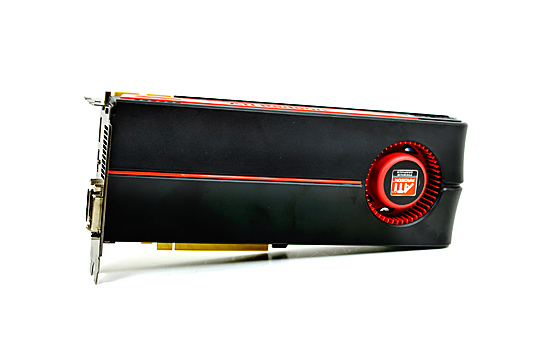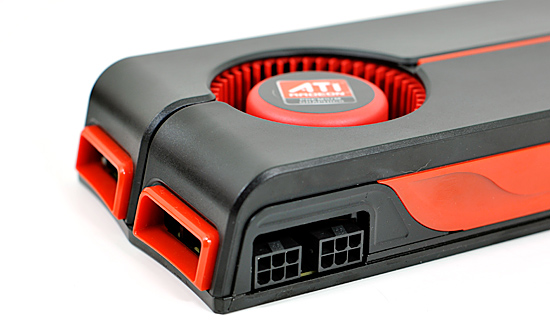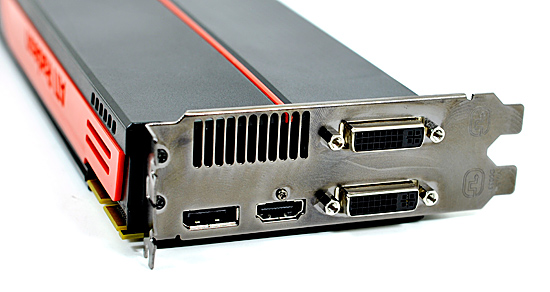AMD's Radeon HD 5870: Bringing About the Next Generation Of GPUs
by Ryan Smith on September 23, 2009 9:00 AM EST- Posted in
- GPUs
Meet the 5870
The card we’re looking at today is the Radeon HD 5870, based on the Cypress core.

Compared to the Radeon HD 4870, the 5870 has seen some changes to the board design. AMD has now moved to using a full sheath on their cards (including a backplate), very much like the ones that NVIDIA has been using since the 9800GTX. The card measures 10.5” long, an inch longer than the 4890 or the same as the 4870x2 and the NVIDIA GTX lineup.
The change in length means that AMD has moved the PCIe power connectors to the top of the card facing upwards, as there’s no longer enough room in the rear. Facing upwards is also a change from the 4870x2, which had them facing the front of the card. This, in our opinion, makes it easier to plug and unplug the PCIe power connectors, since it’s now possible to see what you’re doing.
Since the card has a TDP of 188W, AMD can still get away with using two 6-pin connectors. This is going to be good news for those of you with older power supplies that don’t feature 8-pin connectors, as previously the fastest cards without 8-pin connectors were the 4890 and GTX 285.

Briefly, the 5850 that we are not testing today will be slightly smaller than the 5870, coming in at 9.5”. It keeps the same cooler design, however the PCIe power connectors are back on the rear of the card.
With the 5800 series, DisplayPort is getting a much-needed kick in the pants. DisplayPort (full size) is standard on all 5800 series cards – prior to this it has been rather absent on reference cards. Along with a DisplayPort, the 5870 reference card contains a dedicated HDMI port, and a pair of DVI ports.
Making 4 ports fit on a card isn’t a trivial task, and AMD has taken an interesting direction in making it happen. Rather than putting every port on the same slot of the bracket as the card itself, one of the DVI ports is raised on to the other bracket. ATI could have just as easily only equipped these cards with 1 DVI port, and used an HDMI-to-DVI adapter for the second port. The advantage of going this direction is that the 5800 series can still drive two VGA monitors when using DVI-to-VGA adapters, and at the same time having an HDMI port built in means that no special adapters are necessary to get an HDMI port with audio capabilities. The only catch to this specific port layout is that the card still only has enough TMDS transmitters for two ports. So you can use 2x DVI or 1x DVI + HDMI, but not 2x DVI + HDMI. For 3 DVI-derived ports, you will need an active DisplayPort-to-DVI adapter.
With the configuration AMD is using, fitting that second DVI port also means that the exhaust vent of the 5800 series cards is not the full length of the card as is usually common, rather it’s a hair over half the length. The smaller size had us concerned about the 5870’s cooling capabilities, but as you’ll see with our temperature data, even with the smaller exhaust vent the load temperatures are no different than the 4870 or 4850, at 89C. And this is in spite of the fact that the 5870 is rated 28W more than the 4870.

With all of these changes also comes some changes to the loudness of the 5870 as compared to the 4870. The 27W idle power load means that AMD can reduce the speed of the fan some, and they say that the fan they’re using now is less noticeable (but not necessarily quieter) than what was on the 4870. In our objective testing the 5870 was no quieter than any of the 4800 series cards when it comes to idling at 46.6dB, and indeed it’s louder than any of those cards at 64dB at load. But in our subjective testing it has less of a whine. If you go by the objective data, this is a push at idle and louder at load.
Speaking of whining, we’re glad to report that the samples we received do not have the characteristic VRM whine/singing that has plagued many last-generation video cards. Most of our GTX cards and roughly half of our 4800 series cards generated this noise under certain circumstances, but the 5870 does not.
Finally, let’s talk about memory. Despite of doubling just about everything compared to RV770, Cypress and the 5800 series cards did not double their memory bandwidth. Moving from the 4870 and it’s 900MHz base memory clock, the 5870 only jumps up by 33% to 1.2Ghz, in effect increasing the ratio of GPU compute elements to memory bandwidth.
When looking back at the RV770, AMD believes that they were not bandwidth starved on the cards that used GDDR5. And since they had more bandwidth than they needed, it was not necessary to go for significantly more bandwidth for Cypress. This isn’t something we can easily test, but in our benchmarks the 5870 never doubles the performance of the 4870, in spite of being nearly twice the card. Graphics processing is embarrassingly parallel, but that doesn’t mean it perfectly scales. The different may be a product of that or a product of the lack of scaling in memory bandwidth, we can’t tell. What’s for certain however is that we don’t have any hard-capped memory bandwidth limited situations, the 5870 always outscores the 4870 by a great deal more than 33%.










327 Comments
View All Comments
Ryan Smith - Wednesday, September 23, 2009 - link
We do have Cyberlink's software, but as it uses different code paths, the results are near-useless for a hardware review. Any differences could be the result of hardware differences, or it could be that one of the code paths is better optimized. We would never be able to tell.Our focus will always be on benchmarking the same software on all hardware products. This is why we bent over backwards to get something that can use DirectCompute, as it's a standard API that removes code paths/optimizations from the equation (in this case we didn't do much better since it was a NVIDIA tech demo, but it's still an improvement).
DukeN - Wednesday, September 23, 2009 - link
I have one of these and I know it outperforms the GTX 280 but not sure what it'd be like against one of these puppies.dagamer34 - Wednesday, September 23, 2009 - link
I need my bitstream Dolby Digital TrueHD/DTS HD Master Audio bistreaming codecs!!! :)ew915 - Wednesday, September 23, 2009 - link
I don't see this beating the GT300 as for so it should beat the GTX295 by a great margin.tamalero - Wednesday, September 23, 2009 - link
dood, you forgot the 295 is a DUAL CHIP?SiliconDoc - Wednesday, September 23, 2009 - link
roflmao - Gee no more screaming the 4850x2 and the 4870x2 are best without pointing out the two gpu's needed to get there.--
Nonetheless, this 5870 is EPIC FAIL, no matter what - as we see the disappointing numbers - we all see them, and it's not good.
---
Problem is, Nvidia has the MIMD multiple instructions breakthrough technology never used before that according to reports is an AWESOME advantage, lus they are moving to DDR5 with a 512 bit bus !
--
So what is in the works is an absolute WHOMPING coming down on ati that BIG GREEN NVIDIA is going to deliver, and the poor numbers here from what was hoped for and hyped over (although even PREDICTED by the red fan Derek himself in one portion of one sorrowful and despressed sentence on this site) are just one step closer to that nail in the coffin...
--
Yes I sure hope ati has something major up it's sleeve, like 512 bit mem bus increased card coming, the 5870Xmem ...
I find the speculation that ATI "mispredicted" the bandwidth needs to be utter non-sense. They are 2-3 billion in the hole from the last few years with "all these great cards" they still lose $ on every single sale, so they either cannot go higher bit width, or they don't want to, or they are hiding it for the next "strike at NVidia" release.
erple2 - Friday, September 25, 2009 - link
So you're comparing this product with a not yet release product and saying that the not yet released product is going to trounce it, without any facts to back it up? Do you have the hardware? If not, then you're simply ranting.Will the GT300 beat out the 5870? I dunno, probably. If it didn't, that would imply that the move from GT200 to GT300 was a major disappointment for NVidia.
I think that EPIC FAIL is completely ludicrous. I can see "epic fail" applied to the Geforce FX series when it came out. I can also see "epic fail" for the Radeon MAXX back in the day. But I don't see the 5870 as "epic fail". If you look at the card relative to the 4870 (the card it replaces), it's quite good - solid 30% increase. That's what I would expect from a generation improvement (that's what the gt200's did over the 9800's, and what the 8800 did over the 7900, etc).
BTW, I'm seeing the 5870 as pretty good - it beats out all single card NVidia by a reasonable and measureable amount. Sounds like ATI has done well. Or are you considering anything less than 2x the performance of the NVidia cards "epic fail"? In that case, you may be disappointed with the GT300, as well. In fact, I'll say that the GT300 is a total fail right now. I mean jeez! It scores ZERO FPS in every benchmark! That's super-epic fail. And I have the numbers to back that statement up.
Since you are making claims about the epic fail nature of the 5870 based on yet to be released hardware, I can certainly play the same game, and epic fail anything you say based on those speculative musings.
SiliconDoc - Monday, September 28, 2009 - link
Well the GT200 was 60.96% increase average. AT says so.http://www.anandtech.com/video/showdoc.aspx?i=3334...">http://www.anandtech.com/video/showdoc.aspx?i=3334...
So, I guess ati lost this round terribly, as NVidia's last just beat them by more than double your 30%.
Great, EPIC FAIL is correct, I was right, and well...
Finally - Wednesday, September 23, 2009 - link
Team Green foames out of their mouthes. It's funny to watch.SiliconDoc - Wednesday, September 23, 2009 - link
Glad you are having fun.Just let me know when you disagree, and why. I'm certain your fun will be "gone then", since reality will finally take hold, and instead of you seeing foam, I'll be seeing drool.